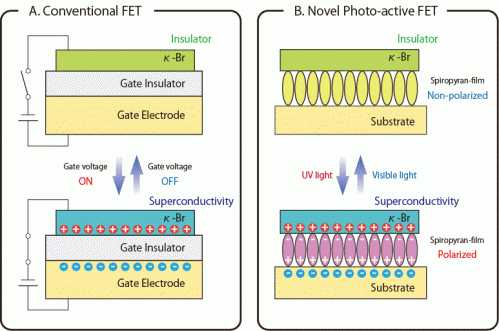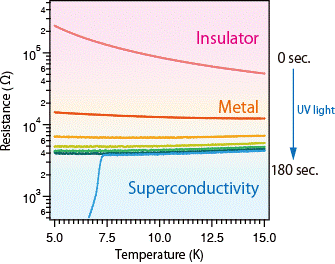Switching superconductivity by light

A research team led by Prof. Hiroshi M. Yamamoto of the Institute for Molecular Science, National Institutes of Natural Sciences has developed a novel superconducting transistor which can be switched reversibly between ON and OFF by light-irradiation. This achievement is a milestone for future high-speed switching devices or highly-sensitive optical sensors.
The field-effect transistor (FET) is a basic switching element that controls electrical current in electronic circuits. FETs are currently included in a variety of electronic devices such as smart phones and computers. In recent years, much effort has been devoted to develop a superconducting FET as a key technology for computations using quantum states.
In 2013, the research team developed the world's first organic superconducting FET based on the organic superconductor: κ-(BEDT-TTF)2Cu[N(CN)2]Br (κ-Br). Their previous work has allowed the organic superconducting FET to be recognized again as having inherent advantages such as flexibility and designability.
In this research, the team fabricated a novel photo-switchable transistor by replacing the gate electrode in the conventional FET with a 'spiropyran'-thin-film. When Dr. Masayuki Suda, a member of the research team, shone a pale UV light on this novel FET, it showed a rapid decrease of electrical resistance and turned into a superconducting state after 180 seconds. Spiropyran is a photo-active organic molecule that shows intra-molecular electrical polarization by UV light irradiation. In this system, carriers for the superconductivity can be accumulated by UV light-induced electrical polarization of the spiropyran-film. Dr. Suda also found that the device can be switched to the superconducting state both by gate-voltage control and light-irradiation control. Such a multi-mode operation obtained by combining two kinds of functional molecules, BEDT-TTF and spiropyran, indicates the high designability of organic systems. The superconductivity could also be removed by visible light-induced depolarization of the film.

This research presents a novel concept in which "superconductivity can be switched by optical stimuli," and will drive innovation in the field of future high-speed switching devices or high-sensitivity optical sensors. "Now it takes 180 seconds to switch the FET, but it can be operated much faster in principle," said Dr. Suda, "and it will open a way to a new type of devices that can satisfy glowing demand for a high-speed information infrastructure."
More information: Light-induced superconductivity using a photo-active electric double layer, Science, www.sciencemag.org/lookup/doi/ … 1126/science.1256783
Journal information: Science
Provided by National Institutes of Natural Sciences





















